I’m going to run through some of my favorite instruments to use when making beats in Garageband. Some of these are plug-ins you’ll have to download, some will require gear, and others just come stock in the software.
The vast majority, however, are completely free. They won’t cost you anything. I’ll explain where and how to get the instruments that don’t come stock in Garageband.
1) The Steinway Grand Piano
This is the stock piano that comes with Garageband. When you first open up Garageband and select “Software Instrument,” and the interface opens up on your screen, you’ll be given the option on the left-hand side: “Piano,” and then “Steinway Grand Piano.”
It says on the left-side, “Bass,” “Drum Kit,” “Electronic Drum Kit” and so on and so forth. Click on piano, and then it says, “Steinway Grand Piano.”
Truthfully, stock pianos are never that great, however, with some reverb, delay, and a bit of ambiance, I find that a lot can be done with the stock piano, especially after having learned how to play from PianoForAll (on my Product Page), which is probably one of the easiest and cheapest ways to learn.
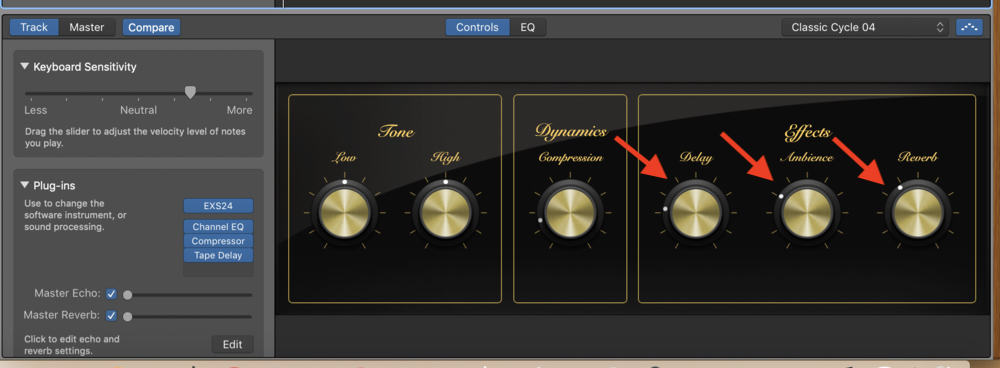
For instance, using the Channel EQ on the piano (my guide) can introduce an entirely different mood to the sound. If you click on the Channel EQ, you’ll notice that the mid-ranges have been attenuated (diminished) just a little bit.
What I like to do is actually boost the mids a little bit. I find this gives the piano a more natural sound to it, but that’s just me.
You can see what this looks like in the image below:
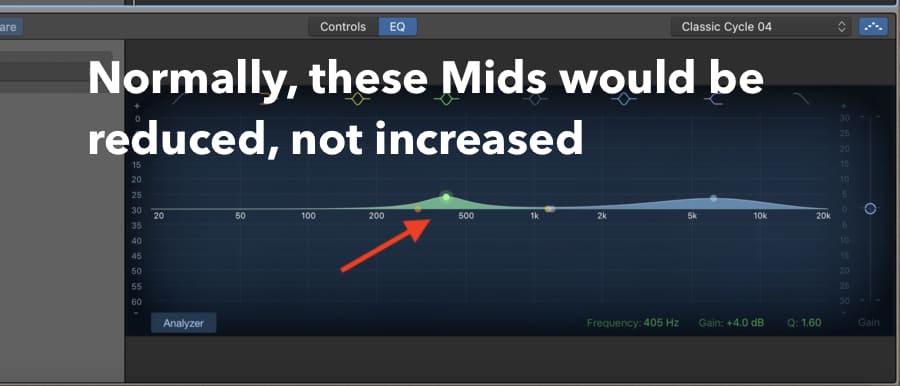
If you’re looking for a nice pre-set to try, try this one:
Delay: 3
Ambiance: 4
Reverb: 5
It’s also worth noting that this piano comes with a ton of different presets and patterns that I’ve highlighted in the image below.
These pre-sets can actually be used on every software instrument in Garageband, so give it a shot.
On the top-right-hand corner of the piano’s interface in the Smart Controls, you’ll notice there is a little icon. Click on it, and it brings up a ton of different pre-sets that are awesome.

You can adjust the note order, the rate at which they’re played (speed), and also the octave range.
2) 4 Front Piano
Let’s say that you hate the Steinway Grand Piano and you’re looking for something that imitates the real thing a little more. In that case, I would recommend picking up the 4Front Piano from Plugins4Free and using my guide to install it.
You can customize it using plug-ings the same way, including compression, EQ, reverb, delay, and so on.

This is a really popular option, so I recommend checking it out.
3) DSK Dynamic Guitars
Due to the fact I’ve played guitar my entire life, I’m really not fond of the stock guitars that Garageband has to offer.
I love the Amp Designer (although Blue Cat Audio’s Axe Pack from Plugin Boutique is way better), but the stock VST guitars are not good. Thankfully, we can download plug-ins to fix this issue.
I recommend grabbing the DSK Dynamic Guitars plug-in which you can grab at the same website I mentioned above.
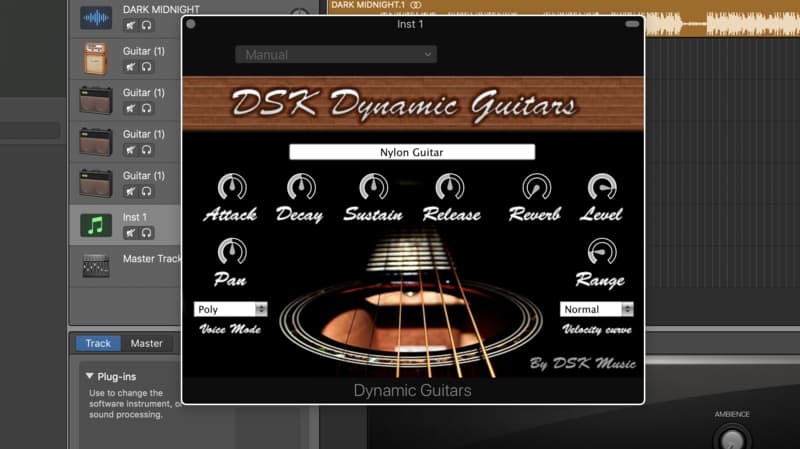
If you don’t like this Dynamics Guitar plug-in, they have other ones like this Nylon string plugin which in my opinion is pretty amazing considering it doesn’t cost money.
4) “Drum Pro” Plug-In From Studio Linked
I can’t praise this plug-in enough (also from Plugins 4 Free), it’s my favorite drum machine plug-in to use, both for its Trap Drum Kit as well as it’s Hip-Hop drum-kits which are pretty sick too.
This plug-in comes with around 20 different kits, and it has some functions on it, including panning, decay, sustain, reverb, attack, release, and volume knobs.
It’s really worth your time to go through each one and figure out the kits and individual instruments that you like.
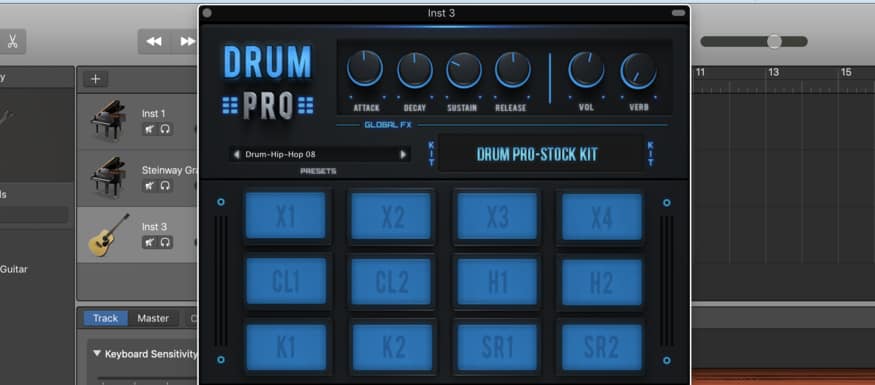
For instance, I like to mix and match different instruments together. I might use the Kick of the Beat Machine and then the Snare of the Hip-Hop 8 drum kit in Drum Pro.
To mix drum-kits, what I like to do is I create a new software instrument track for each part of the kit.
For instance, one Software Instrument track will be the kick and another one will be the snare. Make sure you remember to label them because otherwise your interface/workspace will be a mess.
5) “Beat Machine” – Electronic Drum Kit
This is a stock instrument that’s found in the electronic drum kit section.
This kit probably has my favorite electronic drum kit kick, and the hi-hats and the shaker sound great as well.
With customization, including reverb, EQ, distortion, compression, and perhaps a bit of a delay, a lot can be done to make these default instruments sound awesome.
An added benefit to using the stock drum kits in Garageband is that it comes with a helpful interface, including delay, reverb, attack, drive, crush, as well as a high and low cut.

As I mentioned above, the kick in the Beat Machine is my favorite, and it’s accessed through the Musical Typing at the C of the first octave, C1.
6) Boutique 808
The Boutique 808s are found in the electronic drum kit section as well, just a few options below the Beat Machine.
The Boutique 808 that comes with Garageband isn’t bad either, and with some compression and distortion, the sound can really be improved (however, if you want a fantastic 808 plugin, I can’t recommend Initial Audio’s 808 Studio II enough).
The vast majority of instruments in the Boutique 808, in my opinion, are useless, however, the bass and the hi-hats are great. I typically use the Bass which is in the third octave of the Musical Typing, C3.
As I just mentioned in passing, using distortion and compression on the Boutique 808s are going to fatten up the sound like crazy, so it’s worth trying out.
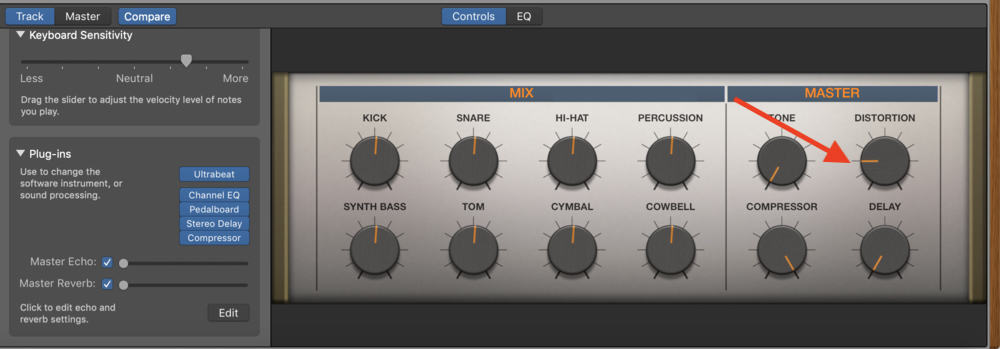
As I explained in my guide on making Boutique 808s, in terms of a compressor pre-set that you can try, go for “Type U Aggressive,” and then notice in the Smart Controls interface of the Boutique 808, there is the option to turn up the Distortion, turn it up to about 3.
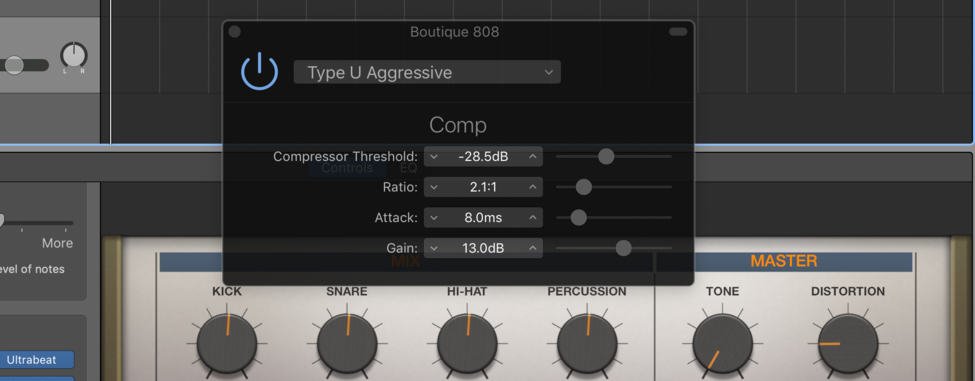
At some point, I’ll be making another tutorial – in fact, I have since made another one featuring 10 tips – on boutique 808s and bass-lines, because I feel like there is still so much to learn and implement.
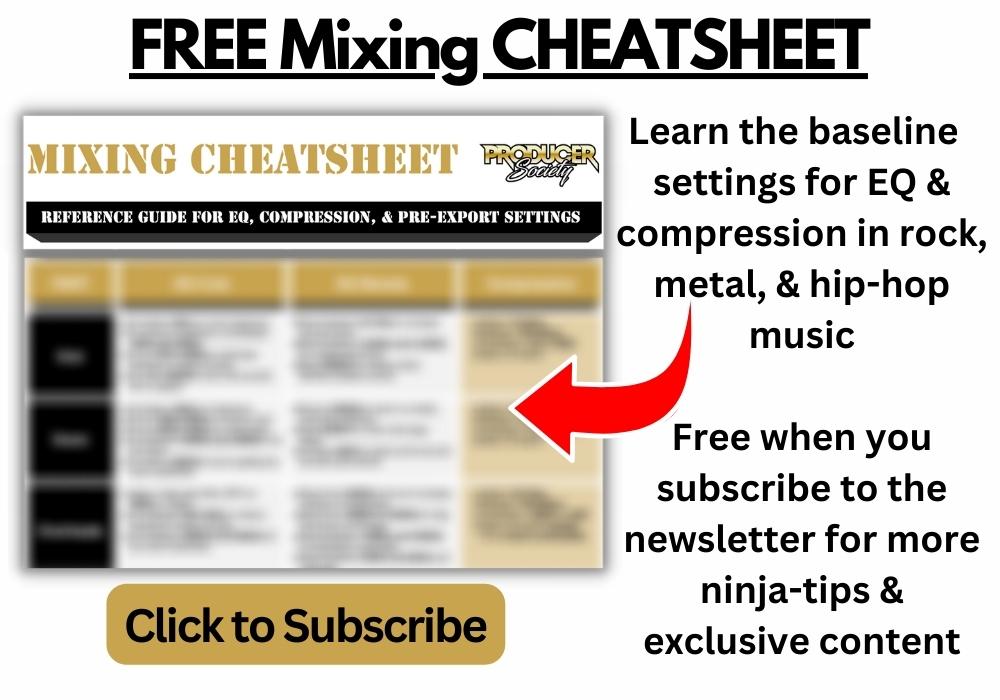
7) Bass Guitar
The bass guitar is found within the Bass category, among a few other styles of the bass guitar.
Truthfully, it’s rare that I like to use this instrument in my actual track, however, what I do like to use this for is developing a nice bass-line that’s easy to hear, and then once it’s ready, I change the software instrument track to the Deep Sub Bass synthesizer.
If you’ve been reading my other articles, you’ll know that human beings can hear the frequencies between 20Hz and 20,000 Hz. However, the easiest frequencies to hear are around 1000Hz-5000Hz.
If you try and make a bass-line with a boutique 808 or a Deep Sub Bass synth right off the start, you might find that you’ve created a bass-line that’s off-key. And the reason for that is simple: you just can’t hear the bass as much and don’t know it’s off-key.
Make sure to try out this tactic, moreover, check out my youtube video on the Ample Bass P Lite II which is a great free bass plugin.
8) Deep Sub Bass Synthesizer
You can find this instrument in the “Synthesizer” category and then in the sub-category, “Bass,” it’s around 3/4 way down the list.
And that brings me to the next instrument, the Deep Sub Bass synthesizer. I’ve been crafting the vast majority of my bass-lines lately with this instrument.
With some EQ and distortion, in conjunction with a properly mixed kick, you can have a bass-line that really slams.
If you want to read more about this instrument and how I go about making bass-lines with it, I recommend checking out the two articles I linked above regarding bass-lines and 808s.
9) Marimba and Vibraphone
You can find both of these instruments in the “Mallet” category.
These two instruments are great for happy-sounding tracks. Frankly, I wouldn’t bother using either of these instruments if you’re making a minor-key trap beat or any hip-hop beat that sounds kind of menacing and dark.
These instruments are made, more so, for creating a melody in a Trippie Redd track, rather than something from Dave East.
It’s worth mentioning that with delay, reverb, flangers, and the presets that come with Garageband, a lot can be done to make these sound unique and super cool.
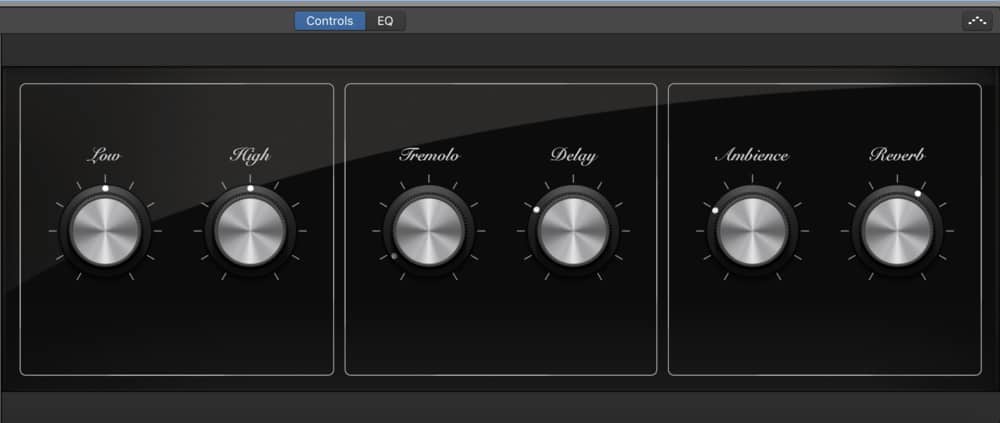
Try out this pre-set just to get your foot in the door:
Delay: 4
Reverb: 7
Ambience: 4
**Arpeggiator: “Bouncing Funk”
**Remember, the arpeggiator is the list of pre-sets that come in stock with every software instrument track on the top-right hand side of the Smart Controls.
10) Flute Solo
You can find this one in the “Orchestral” category, and then in the sub-category, “Woodwinds.”
In the last 5-6 years, the flute has really become one of the most popular instruments for hip-hop producers to use, I believe because of Drake and his choice of producers, but I’m not entirely sure.
However, the annoying thing about this VST is the fact it’s not very responsive to the MIDI Keyboard or the Musical Typing.
I think they did this on purpose to imitate the time it takes to actually inhale and then blow into the flute as if you’re actually playing it in real life.
There’s another flute that you can use as well, which I’ll talk about a bit later in this article.
11) DSK Saxophones
This is another plug-in from DSK, who, in my opinion, make some of the better instrument VSTs which you can find on Plugins4Free. This VST from DSK is a lot better than the saxophone that comes stock in Garageband.

Personally, I enjoy using the Tenor Sax a lot more than the Soprano Sax, the Tenor has a much smoother and chilled out vibe, which is probably what you’ll intend on using it for, rather than the Soprano Sax, which has more of a high-pitched and “wailing” sound to it. With some reverb and delay, possibly even a flanger, a lot can be done to spice up the sound of the saxophone.
12) Air Bells, Delicate Bells, Antarctic Sun, and Splatter Tables
You can find these within the “Synthesizer” category and then in the sub-category, “Bells.”
For this one, I included 4 of them within the same number, because they’re all in the same sub-category.
For each one of these, it’s worth your time to go through and adjust the parameters in Garageband’s interface, for instance, the reverb, delay, and so on and so forth. You can end up making something entirely unique and to your specific tastes.
13) Scream Lead
You can find this one in the “Synthesizer” category as well, and in the sub-category, “Lead.”
With some customization, in my opinion, it can kind of sound like the classic sound that Dr. Dre used to use in all of his songs from back in 2001 and in the early 1990s.
If you want to try and get this sound, I’d recommend using it in the Third Octave, in other words, “C3” or “C4” using Garageband’s Smart Controls.
Moreover, it wouldn’t hurt to decrease frequencies between 5000Hz and 20,000Hz just to eliminate the shrill sound of it, that’s if you’re trying to imitate the Dr. Dre sound from The Chronic, especially the lead melody from “Let Me Ride.”
Pay attention to the way this sound is mixed, because with some reverb, and the instrument turned down in the mix, you can really imitate that Dre synthesizer that he used to use so much back in the day.

For this one, I recommend playing around with the “Glide,” “Sub,” and the “Shape” parameters, especially the “Glide.” With the “Glide” function, you can move smoothly between notes and create a really cool effect.
14) Bebob Organ
You can find this one in the category, “Vintage B3 Organ.”
The Bebob organ, or any of the other organs, are more of a complementary instrument in my opinion because they can fill out a track very nicely if the instrument is turned down in the mix and panned correctly while using my guide as a reference.
15) Vintage Mellotron
I included this entire category as one instrument because frankly, nearly every single instrument offered in this category is a killer if you ask me.
Within this category, you have the Cello, Flute (different from the other flute), the Mixed Choir, 3 Violins, as well as the Strings & Flute together.
My personal favorite among these is to mix the Cello and then the Strings and Flute together, but mixing both of these instruments relatively low, due to the fact they can stand out quite a bit.
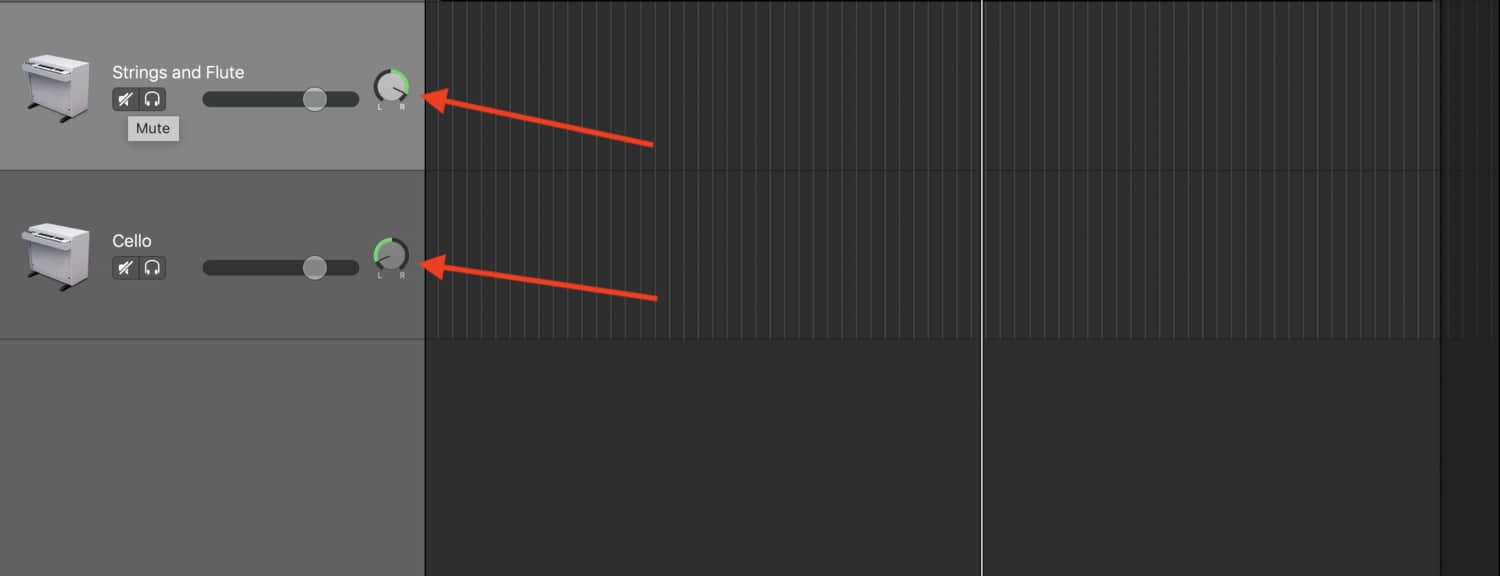
You also want to pan the cello to about 8:00 pm, and then the Strings and Flute at about 4:00 pm. That’ll open up the mix a little bit and create a song with more room.
16) Erhu
You can find this instrument in the “World” category and within the “Stringed” instrument section.
This is probably my favorite instrument to create melodies in Garageband. I’m crazy about it, I think it’s amazing.
Especially the parameters that come with it, including the “Auto-Vibrato” function which sounds awesome when it’s turned up about halfway.

I’ve used it in a bunch of different songs, and there’s no question that it’s one of my favorites.
When paired with #15 on the list, and mixed accordingly, I think you can come up with some awesome sounds in a track.
17) Guzheng
Like the Ehru, you can find this instrument in the “World” category and then in its “Stringed” instrument sub-section.
From what I understand, this is a traditional Chinese instrument, so if you’re trying to go for some Wu-Tang Clan style beats, particularly the track, “Da Mystery Of Chessboxing,'” then this is definitely the instrument of choice for you.
18) Arpeggiators – Dripping Cycles, Erratic Motion, Glass String Structures, Zen Garden, and Digital Rain Drops
Find these instruments under the Arpeggiator category, and then within the Synth Basics and Synth Bells sub-category.
Regarding the use of the arpeggiators, what I typically do is I create the melody with the 4Front or Steinway Grand Piano first, and then I switch it over to one of the arpeggiators to see which one sounds the coolest.
This is the primary way I use arpeggiators, and I find it’s the fastest way to beef up a song and add a bit of background melody without doing a ton of work.
Different people have different methods, so you could also try and create the melody with the arpeggiator first, however, I typically try and create it with the piano first. I find this works well.
19) A Real Guitar
For this one, you obviously have to have a real guitar and also know how to play it. Nothing beats the real instrument in my opinion – with some exceptions, which is why I recommend the PRS SE Custom 24 or the Epiphone Les Paul ’59 Reissue.
If you’re a guitar player and you’re looking to introduce the instrument you’ve played for years into your productions, I’d recommend checking out this article on how to plug your guitar into Garageband.
Some of my favorite presets and Amps to use are the following:
Find these ones in the Clean Guitar sub-category:
Clean Echoes
Cool Jazz Combo
Dublin Delay
Dyna-Trem
Mystery Chorus
Blue Wave – You can find this one in the Experimental Guitar sub-category which I talked about more in my Amp Designer tutorial.
20) Pads
Find the pads below under the Synthesizer category, and then under the Pads category.
Here are some of my favorite pads to use in alphabetical order:
Airways, Boarding Area, Breathy Vox, Emerald Haze Pad, Ocean Sun Glitters, and Sun Glitters Pad.
Like every other instrument, it’s up to you to figure out how you want to customize the sound.
As I’ve mentioned in passing above, because a lot of these instruments are stock in Garageband, the interface serves the purpose of customization well, so playing around with options like the “Glide” and the “Delay” is going to make a big difference in how some of these sound.
Each pad comes with its very own set of parameters that you can play around with, and if you want more, you can always grab XPand! 2 (on my Product Page), which is a very inexpensive plugin that features a ton of similar instruments.
21) Soundscape – “Event Horizon” and “String Movements”
You can find these two instruments within the Synthesizer category, and then under the Soundscapes category
These two instruments kind of serve the same purpose, in my opinion, as the arpeggiators, because they’re extremely easy to use in terms of filling out the rest of the mix without having to do a lot of work.
Just copy the main melody that you’ve created and then open up a new Software Instrument track, select the synth/pad/arpeggiator, and paste it in there to see what kind of effects you can make.
In the case of these two instruments, however, simple chord progressions sound the best due to the way they work.
For instance, if you just play two chords like the C Major and A Minor chord and hold them after one another, it can create a super ambient vibe.
**Mainstage 3 – Not Free
It’s worth mentioning that you can actually purchase more instruments for Garageband in the app store. I believe it’s called Mainstage 3, and I think it costs around $39.99 for the whole thing.
I have to add that I haven’t actually bought it and tested it, but to be honest, I haven’t heard many people talk about this and whether or it’s not good.
I think I might actually make an article on it someday after I try it out.
YouTube Video Tutorial
Conclusion
All in all, I hope this was helpful for you and you managed to get some solid sounds and instruments from this tutorial. Do me a solid and share this on your social media with your producer friends. I’d appreciate that a lot. Every bit counts.


 Written By :
Written By : 